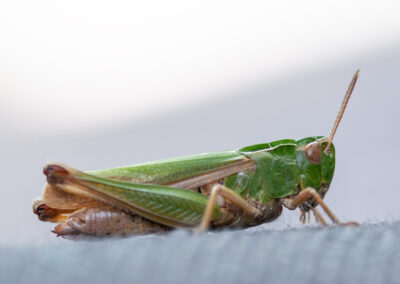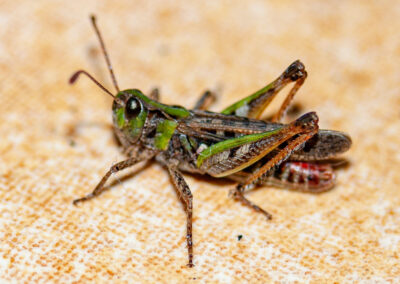Grasshoppers, Crickets, Earwigs & Stoneflies
I have grouped these orders of insects together as they share some characteristics, though there is currently some lack of certainty about their taxonomic relationships.
One characteristic they all have in common is that they undergo incomplete metamorphosis, in that there is no pupal stage – they hatch from eggs, then live as larvae / nymphs until their final moult, when they emerge as an adult.
Grasshoppers & Crickets
Grasshoppers, true crickets and bush crickets belong to the order Orthoptera.
There are 11 native species of grasshoppers and 23 species of crickets in the UK, including a few naturalised species. As far as I know, there are no crickets of either type living in Dernol.
Common Green Grasshopper (Omocestus viridulus) (0890)_960
Common Green Grasshopper (Omocestus viridulus)
Common Green Grasshopper (Omocestus viridulus) (0894)_960
Common Green Grasshopper (Omocestus viridulus)
They over-winter as eggs, which hatch in spring when the weather warms up; they then go through between 4 and 6 nymphal stages (instars), which look like smaller versions of the adults, before the final adult stage is reached in about July.
One of the main distinguishing features between grasshoppers and crickets is their antennae – most grasshoppers have short, stubby antennae, those of crickets are much longer and thinner. Crickets are generally larger than grasshoppers.
Both grasshoppers and crickets have powerful hind legs, enabling them to jump large distances. All grasshoppers other than the Meadow Grasshopper have two pairs of wings with which they can fly; those of the Meadow Grasshopper are short and stunted.
Grasshoppers and crickets are more often heard than seen, the ‘call’ of a grasshopper being a feature of hot summer days, with crickets more likely to call in the early evening. Grasshoppers make this noise (stridulation) by rubbing a row of small pegs on their rear legs against the hard, thickened edge of their front wings. Bush crickets make their call by rubbing their wings together.
They feed mostly on plant material, preferably leaves, but sometimes eat small insects, including aphids, so can be beneficial to gardeners – though there a few species, the locusts, that are a serious pest at their swarming phase in some parts of the world.
Earwigs
Earwigs belong to the order Dermaptera, and 7 species are found in the UK.
They do have membranous wings, folded underneath the short, hard forewings (tegmina), but rarely fly. They are best known for the pincers (cerci) at the rear of their abdomen (curved in males, straight in females), which are used to capture prey, to help fold their wings away, and for defence.
They are one of the few non-social insects that care for their young both as eggs and after hatching, until their third instar stage. They have between 4 and 6 nymph (instar) stages.
They are mostly nocturnal, hiding in damp places in the daytime, and often when a rock, flowerpot or piece of wood is overturned.
They feed on a wide variety of decaying plant and animal materials, but also eat the occasional insect, and can damage many garden plants by eating the leaves and flowers – though rarely in sufficient numbers to bother about.
Stoneflies
Stoneflies belong to the order Plecoptera, and there 34 species known to live in the UK.
The eggs are laid into water, and are sticky so that they can adhere to rocks and not be swept away. After hatching, they stay in nymphal form for 1 – 4 years, going through 12 – 36 moults. Like dragonflies, the final stage nymph will emerge from the water, and by one last moult emerge as an adult. The adults live for only a few weeks, and rarely fly far from the water from which they emerged.
The adults have two pairs of transparent wings, the hindwings being broader then the forewings. Both nymphs and adults have a pair of long filaments (cerci) at the rear of the abdomen.
The nymphs are predators on a wide range of other small inhabitants of the water, and are themselves often eaten by fish.
They are very intolerant of poor water quality, so their presence is a good sign. I have seen them in Dernol, but have yet been unable to photograph any.






